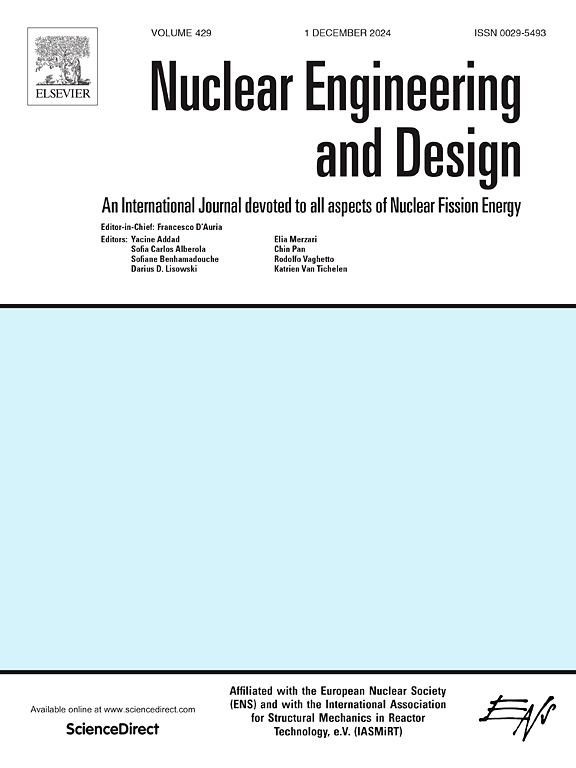Position control of water hydraulic high-speed on-off valves-controlled cylinder of water hydraulic manipulator
IF 1.9
3区 工程技术
Q1 NUCLEAR SCIENCE & TECHNOLOGY
引用次数: 0
Abstract
Water hydraulic systems offer the advantage of minimizing pollution, rendering them highly compatible with nuclear radiation environments. In this study, a 7 degrees of freedom (DOF) water hydraulic manipulator, based on seven water hydraulic high-speed on–off valves (HSVs)-controlled cylinder systems, is developed for operations in pollution-free environments. A co-simulation model for HSVs-controlled cylinder is established by AMESim, Maxwell, and Simulink. To improve the precision of manipulator joint control, a control strategy involving double voltage and variable frequency (DV+VF) for HSVs is introduced to ensure optimized flow output at any duty cycles. This approach effectively mitigates the decrease in position control accuracy caused by dead or saturated zones. Addressing the asymmetry within water cylinders, the DV+VF and double sliding mode control (DV+VF+DSMC) is proposed and implemented to achieve precise position tracking of the joint. Experimental results showcase that the displacement error of DV+VF+DSMC is within 0.5 mm while exhibiting stronger robustness. Furthermore, to simulate the working performance in high-pressure and pollution-free environments, the water hydraulic manipulator is tested within a high-pressure simulation device. The results indicate smooth and flexible movement for each manipulator joint, affirming its effectiveness in high-pressure and pollution-free environments.
液压高速开关阀控液压机械手缸的位置控制
水液压系统具有最大限度地减少污染的优点,使其与核辐射环境高度兼容。本文研究了一种基于7个水液压高速开关阀(hsv)控制缸系统的7自由度水液压机械臂,用于无公害环境下的作业。利用AMESim、Maxwell和Simulink建立了hsv控制气缸的联合仿真模型。为提高机械手关节控制精度,提出了一种双电压变频(DV+VF)控制策略,以保证任意占空比下的流量输出最优。该方法有效地缓解了死区或饱和区对位置控制精度的影响。针对水缸内部不对称的问题,提出并实现了DV+VF和双滑模控制(DV+VF+DSMC),实现了关节的精确位置跟踪。实验结果表明,DV+VF+DSMC的位移误差在0.5 mm以内,具有较强的鲁棒性。此外,为了模拟高压无污染环境下的工作性能,在高压仿真装置内对水液压机械手进行了测试。结果表明,机械手各关节运动平稳、灵活,在高压、无污染环境下的有效性得到了肯定。
本文章由计算机程序翻译,如有差异,请以英文原文为准。
求助全文
约1分钟内获得全文
求助全文
来源期刊

Nuclear Engineering and Design
工程技术-核科学技术
CiteScore
3.40
自引率
11.80%
发文量
377
审稿时长
5 months
期刊介绍:
Nuclear Engineering and Design covers the wide range of disciplines involved in the engineering, design, safety and construction of nuclear fission reactors. The Editors welcome papers both on applied and innovative aspects and developments in nuclear science and technology.
Fundamentals of Reactor Design include:
• Thermal-Hydraulics and Core Physics
• Safety Analysis, Risk Assessment (PSA)
• Structural and Mechanical Engineering
• Materials Science
• Fuel Behavior and Design
• Structural Plant Design
• Engineering of Reactor Components
• Experiments
Aspects beyond fundamentals of Reactor Design covered:
• Accident Mitigation Measures
• Reactor Control Systems
• Licensing Issues
• Safeguard Engineering
• Economy of Plants
• Reprocessing / Waste Disposal
• Applications of Nuclear Energy
• Maintenance
• Decommissioning
Papers on new reactor ideas and developments (Generation IV reactors) such as inherently safe modular HTRs, High Performance LWRs/HWRs and LMFBs/GFR will be considered; Actinide Burners, Accelerator Driven Systems, Energy Amplifiers and other special designs of power and research reactors and their applications are also encouraged.
 求助内容:
求助内容: 应助结果提醒方式:
应助结果提醒方式:


